
A Mathematical Theory of Visual Hallucinations
entoptic imagery
gif

entoptic imagery
gif
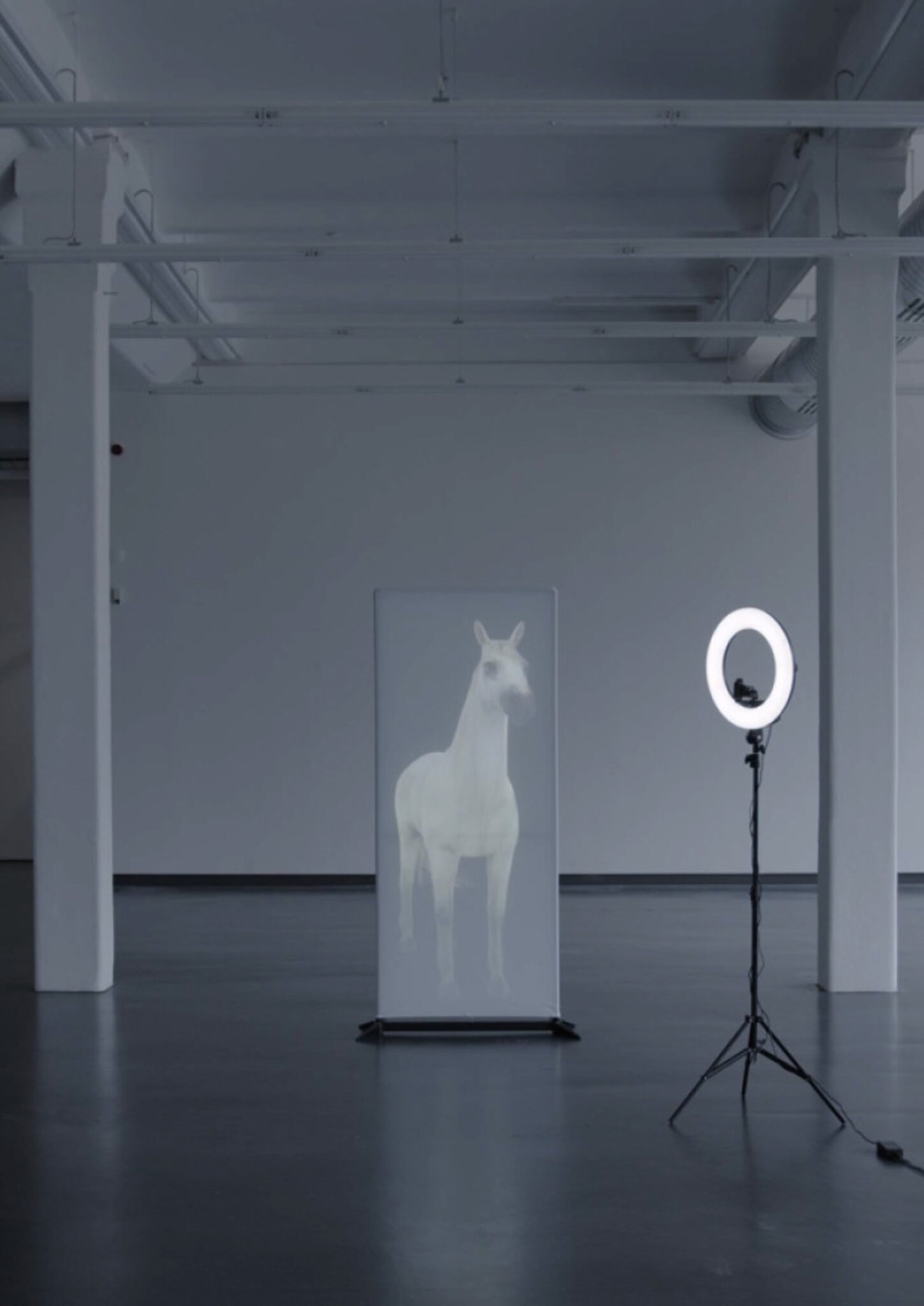
Smart Hans
FILE 2024 | Installations
International Electronic Language Festival
Max Haarich (Project Smart Hans) – Smart Hans – Germany
The Smart Hans project is a synthetic reincarnation of Clever Hans, a horse that became famous in the early 20th century for apparently answering mathematical questions by tapping its hoof. The interactive installation features an animated horse that can guess any number in its mind through posture recognition. At the same time a fun joke and an illustration of why we worry about artificial intelligence.
Bio
Max Haarich is an artistic researcher, ethicist and consultant focusing on artificial intelligence and web3. He studied communication science at RWTH Aachen and critical thinking at the University of the Underground. After his studies, he researched artificial superintelligence at RWTH Aachen and later worked as a communications manager at Europe’s leading startup hub.
Credits
Team: Anja Borowicz Richardson (UK), Bruce Gilchrist (UK), Akshita Gupta (IND), Max Haarich (Artistic Lead/DE), Martina Huynh (NL), Asad Imtiaz (PAK), Muhammad Qasim Khan (PAK), Adrian Ludwig (DE), Pekka Ollikainen (FI), Raphael Pickl (DE).

Originally from Wuhan, China, Terrence Zhou is a promising fashion designer based in New York City. Having a background in design and mathematics, Terrence leans on his multifaceted understanding of Chinese tradition, mathematics, Greek mythology and artistry to create collections seemingly out of this world.
.
Terrence Zhou 来自中国武汉,是纽约市一位很有前途的时装设计师。拥有设计和数学背景的 Terrence 凭借对中国传统、数学、希腊神话和艺术的多方面理解,创作出看似与世隔绝的系列。

Entwurf
Blueprint umfasst die Beziehung und Parallelen zwischen Kunst und Wissenschaft und schafft Kompositionen durch die mathematischen Prinzipien der Logik, die das Leben stützen. UVA untersucht Analogien zwischen DNA und Computercode und hat die Blueprint-Serie entwickelt. Arbeiten, die Genetik und Code als Blaupausen künstlicher und natürlicher Systeme verbinden. Da sich die Arbeit im Laufe der Zeit langsam ändert, schwanken die Muster zwischen verschiedenen Komplexitätsgraden. Blueprint verwendet die Grundkonzepte der Evolution, um ein sich ständig veränderndes Bild zu erstellen. Während Zellen ihre Gene buchstäblich auf ihre angrenzenden anderen übertragen, fließt Farbe wie Farbe über die Leinwand. Blueprint erstellt jede Minute eine einzigartige farbenfrohe Komposition und präsentiert das unbegrenzte Ergebnis, das sich aus einem einzigen Algorithmus ergibt. ein einziges Regelwerk.
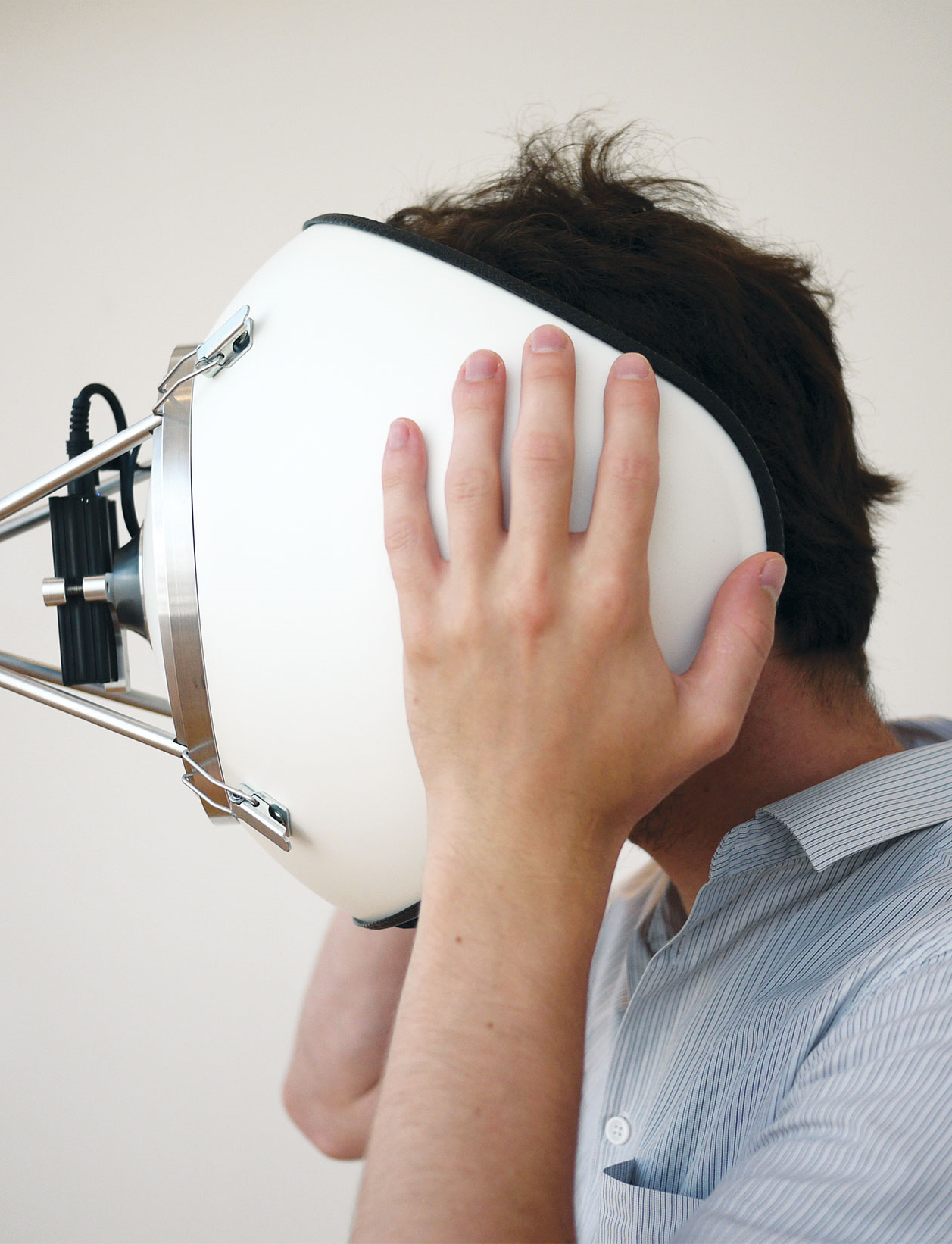
Die Wilden Dinger
Das wilde Ding, in Kastanienstreifen modellierte und im Volumen der Galerie schwebende Wurmlöcher sind Teil der Fortsetzung eines Projekts, das am CCA von Kitakuyshu in Japan mit erfahrenen Bambushandwerkern initiiert wurde. Ein anderer Ort, eine andere Technik, eine andere Kultur … Von der Absurdität einer mathematischen Reproduktion mit Naturprodukten, um nicht besser das virale Trium zu spielen, das Faustino lieb ist: Kunst, Handwerk, Architektur.

61/6 haut-parleurs
Tacit Group est un groupe de performance audiovisuelle qui a été formé en 2008 pour créer une œuvre axée sur l’algorithmique et l’audiovisuel. Son art algorithmique se concentre sur le processus plutôt que sur le résultat. Ils créent du code mathématique, des systèmes utilisant des principes et des règles, et improvisent des performances scéniques à l’aide des systèmes. Pendant la représentation, les systèmes sont révélés visuellement et sonorement, afin que le public puisse entendre avec leurs yeux, comme on voit “Le Cri” d’Edvard Munch (Norvège, 1863-1944). Les images font partie intégrante du travail du Groupe Tacit en tant que compositeurs et artistes médiatiques. Ils espèrent qu’en montrant non seulement la pièce finie, mais le processus de discussion ou de jeu qui la génère, ils engageront plus intensément leurs téléspectateurs et briseront la division conventionnelle entre les interprètes et les membres du public. Aucun de ses travaux n’est jamais terminé. Ils mettent continuellement à jour les systèmes sous-jacents et s’inspirent de leur pratique de la programmation informatique. En tant qu’artistes de notre époque, Tacit Group découvre les possibilités artistiques de la technologie.
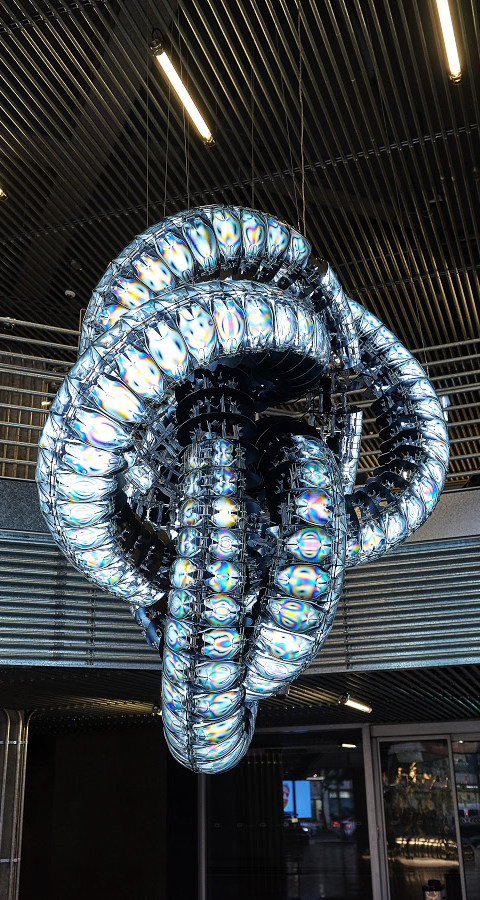
CHROMA III
Kim ist bekannt für seine mechanischen Skulpturen, die wissenschaftliche und mathematische Theorien einbeziehen, und auch als Komponist elektroakustischer Musik. Für diese Triennale präsentiert Kim Chroma III, das die Knotentheorie in der Mathematik anwendet, um Hunderte von Polymerzellen […]
.
Kim is known for his mechanical sculptures that incorporate scientific and mathematical theories and also as a composer of electroacoustic music. For this Triennale, Kim presents Chroma III, which applies knot theory in mathematics to structure hundreds of polymer cells […]
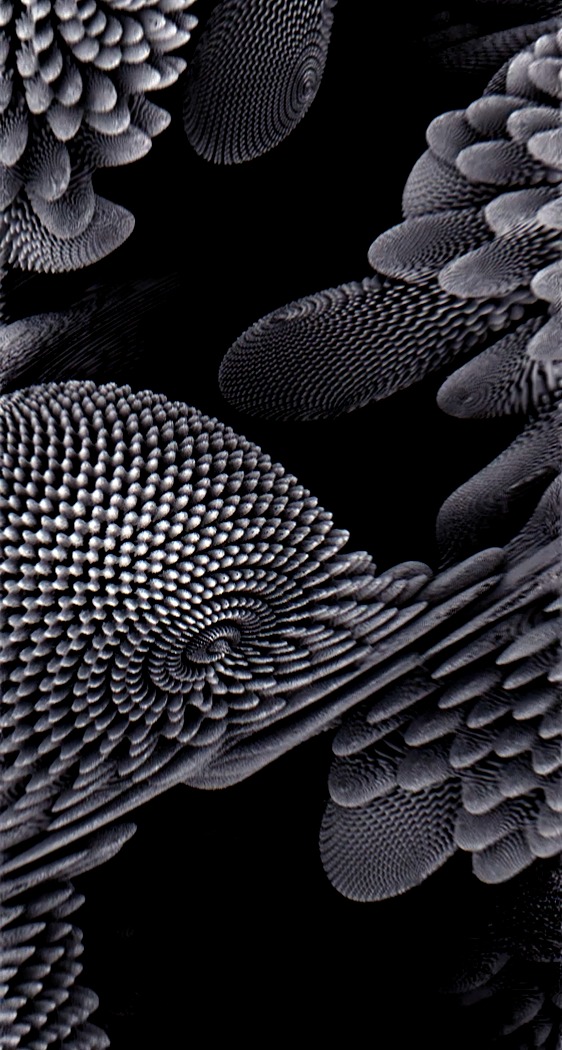
HYPER FRACTAL
When I was a child I had some vivid dreams. They felt like I was falling and flying into an infinite multi-dimensional environment. They were satisfying and terrifying at the same time but I couldn’t find any explanation for them. 6 years ago I read about Benoit Mandelbrot’s theory, the fractals, and it changed my perspective. I realized that my dreams were fractals. So I tried to remake my dreams as a visual VR experience. According to Benoit Mandelbrot’s theory, Fractals are the mathematical\visual explanation of the nature’s structural geometry. Geometry for irregularity.

Morphogenetic Creations
Created by a mathematician, digital artist and Emmy award winning supervisor of computer generated effects – Andy Lomas, Morphogenetic Creations is a collection of works that explore the nature of complex forms that can be produced by digital simulation of growth systems. These pieces start with a simple initial form which is incrementally developed over time by adding iterative layers of complexity to the structure.The aim is to create structures emergently: exploring generic similarities between many different forms in nature rather than recreating any particular organism. In the process he is exploring universal archetypal forms that can come from growth processes rather than top-down externally engineered design.Programmed using C++ with CUDA, the series use a system of growth by deposition: small particles of matter are repeatedly deposited onto a growing structure to build incrementally over time. Rules are used to determine how new particles are created, and how they move before being deposited. Small changes to these rules can have dramatic effects on the final structure, in effect changing the environment in which the form is grown. To create these works, Andy uses the GPU as a compute device rather than as a display device. All the data is held in memory on the GPU and various kernel functions are called to do things like apply forces to the cells, make cells split, and to render the cells using ray-tracing. The simulations and rendering for each of the different animated structures within this piece take about 12 hours to run, Andy explains. By the end of the simulations there are over 50,000,000 cells in each structure.The Cellular Forms use a more biological model, representing a simplified system of cellular growth. Structures are created out of interconnected cells, with rules for the forces between cells, as well as rules for how cells accumulate internal nutrients. When the nutrient level in a cell exceeds a given threshold the cell splits into two, with both the parent and daughter cells reconnecting to their immediate neighbours. Many different complex organic structures are seen to arise from subtle variations on these rules, creating forms with strong reminiscences of plants, corals, internal organs and micro-organisms.

Blueprint
Blueprint embraces the relationship and parallels between art and science, creating compositions through the mathematical principles of logic that underpin life. Exploring analogies between DNA and computer code, UVA have created the Blueprint series; works that pair genetics and code as the blueprints of artificial and natural systems. As the work slowly changes over time, patterns fluctuate between varying degrees of complexity. Blueprint uses the basic concepts of evolution to create an ever-transitioning image. With cells literally transferring their genes to their adjoining others, colour flows like paint across the canvas. Drawing up a unique colourful composition every minute, Blueprint presents the unlimited outcome that results from a single algorithm; a single set of rules.
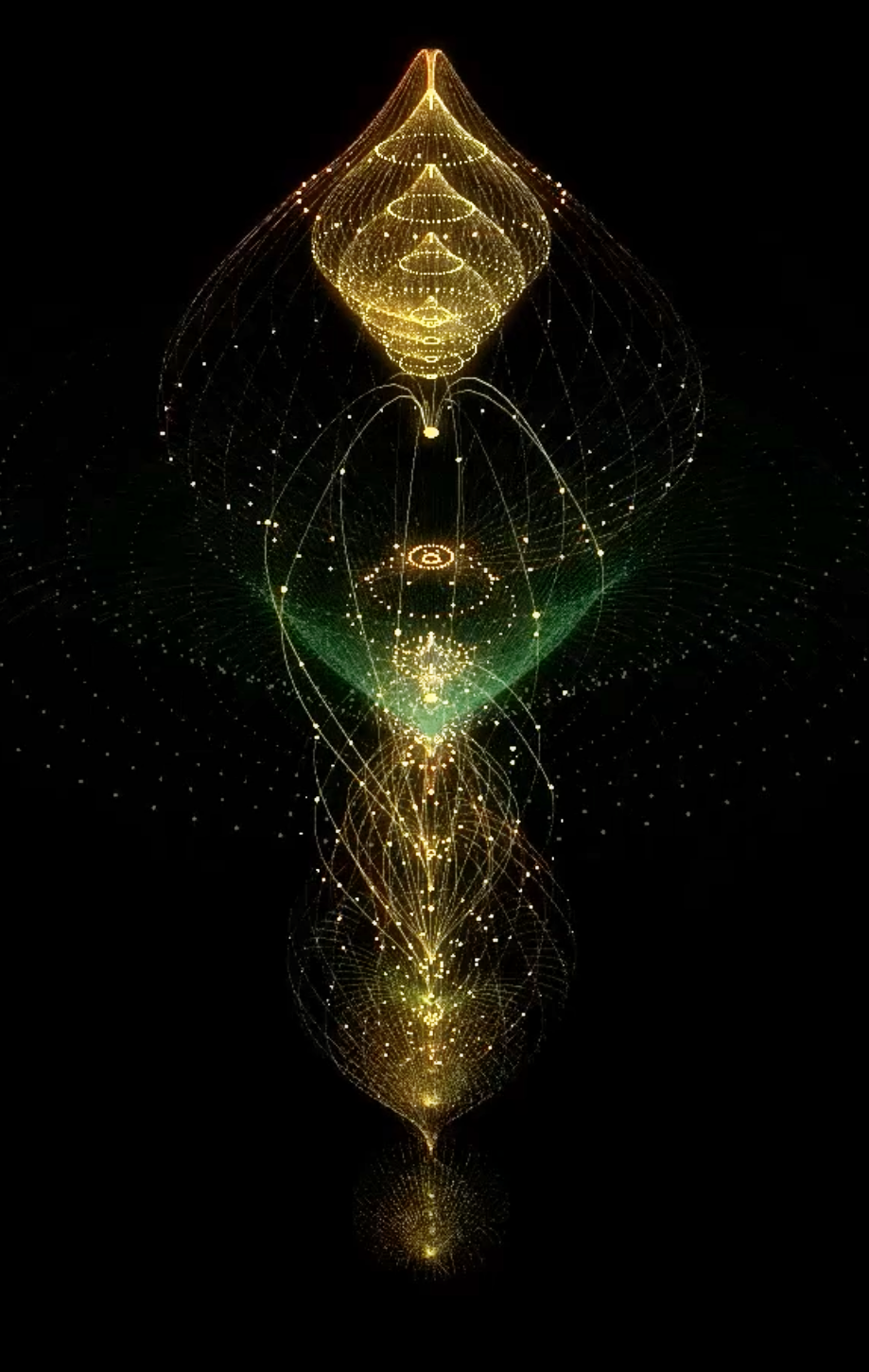
Antrum
The installation looks like a grotto of the membrane, the surface of which is inhabited by strange creatures. It’s complex structure causes association with living creatures, space objects and architectural constructions. In this frontier word pure mathematical abstractions are mixed with natural shapes, resulting in formation of new entities. Viewers can push the membrane and try to contact with them.
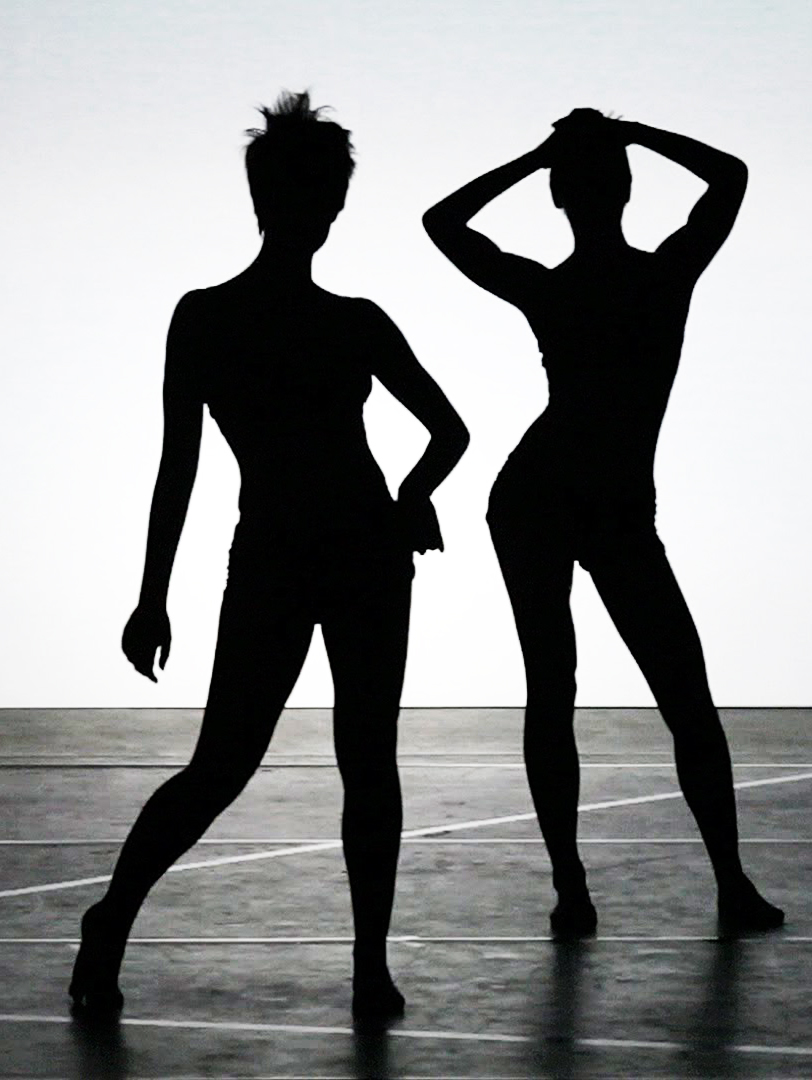
克劳斯奥伯迈尔
the concept of … (here and now)
In front of a giant screen, two dancers interact with a cohort of cameras… Their movements are captured by infra-red sensors and projected onto the screen, whereby their bodies become the canvas on which new images take shape. The result is a shifting kaleidoscope of strange, living, quasi-mathematical visual worlds which sometimes seem to be emanating or even escaping from the dancers’ bodies. “Who decides which movement to make: the man or the machine?” Blurring the line between the real and the virtual, Klaus Obermaier loves to subsume his performers’ bodies and physicality in a disconcerting digital universe. With his latest creation, the choreographer/artist has taken a bold new step. He has constructed a system of projectors and infra-red sensor-cameras, trained upon the movements of two dancers. The performers thus find themselves thrown headlong into a living, moving graphical universe: their movements are projected onto the screen, but at the same time their bodies are illuminated by more projected images. This is a true artistic performance, pushing well beyond the frontiers of a standard dance recital, or even a contemporary dance show. A corporeal, temporal performance. A choreography which makes subtle use of its raw materials, deftly combining lights, video, perspectives and the real-time power of bodily movement.

THE TRANSPARENCY OF RANDOMNESS
“The Transparency of Randomness” gives insight into the world of randomness. In this interactive installation, visitors can directly experience the significance of the complex interplay of randomness and stochastics in current mathematical and physical research. 27 transparent boxes, floating in space, continuously generate random numbers by using the well-known medium of the dice.The process of random number generation is influenced by the complexity of nature and its structures, using a variety of natural materials. The ensemble of all generated random numbers forms the basis of a real-time calculation and comprehensibly demonstrates the impressive role in scientific research.
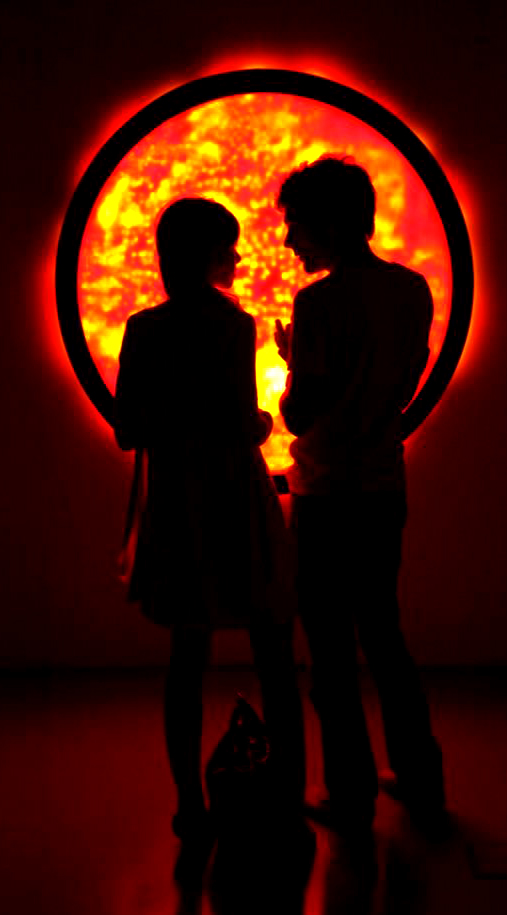
Рафаэль Лозано-Хеммер
拉斐尔·洛萨诺 – 亨默
ラファエル·ロサノ=ヘメル
라파엘 로자노
רפאל לוזאנו, המר
Flatsun
A circular display that simulates the turbulence at the surface of the Sun using mathematical equations. The piece reacts to the presence of the public by varying the speed and type of animation displayed. If no one is in front of the piece the turbulence slows down and eventually turns off. As the built-in camera detects people more solar flares are generated and the fake Sun shows more perturbation and activity. At 140 cm diameter, Flatsun is exactly a billion times smaller than the real Sun. The piece consists of custom-made panels with 60,000 red and yellow LED lights, a computer with 8 processing cores, a camera with a pinhole lens and a mechanically engineered aluminium, steel and glass structure that pivots for maintenance. A single knob lets the collector set the brightness of the piece and turn it on and off.

Cloud Pergola
Inspired by the cloud formations and weather events, this mathematized cloud plays with visitor’s perception. Movement through the structure generates a series of dynamic interference views in its deep fabric, drifts and ruptures in visibility. A sea of redirecting vectors is pulling the visitor like an invisible gravity force through the fabric.

Datum
Any pixel in a digital movie file can be described as a point in 6-dimensional Euclidean space [x,y,R,G,B,t]. the rotations in 6-dimensioal space converts curve in form to gradation in colour, colour to motion in time axis, motion to curve and curve to colour. relations beween all of pixels are mathematically conserved through the conversion.
this visual object is “mathematically” digital colour movie data itself as sequence of numbers. it’s a nature of data.

Licht, mehr Licht!
“Licht, mehr Licht!”, or “Light, more light!” in English, were the great German author and scientific thinker Goethe’s dying words. The installation, created and developed by French visual artist Guillaume Marmin, echoes near-death experiences, whose survivors describe a “tunnel of light” opening up beyond the darkness. Marmin’s works give form to the intangible, unveiling the beauty of the unseen and the mathematical foundations of reality.

池田亮司
이케다 료지
РЕДЗИ ИКЕДА
superposition
superposition is a project about the way we understand the reality of nature on an atomic scale and is inspired by the mathematical notions of quantum mechanics. Performers will appear in his piece for the first time, performing as operator/conductor/observer/examiners. All the components on stage will be in a state of superposition; sound, visuals, physical phenomena, mathematical concepts, human behaviour and randomness – these will be constantly orchestrated and de-orchestrated simultaneously in a single performance piece.

蒂姆·霍金森
ティム·ホーキンソン
تيم هاوكينسون
Möbius Ship
The ambitious and imaginative structure of Hawkinson’s sculpture offers an uncanny visual metaphor for Melville’s epic tale, which is often considered the ultimate American novel. Möbius Ship also humorously refers to the mathematical concept of the Möbius Strip. Named after a nineteenth-century astronomer and mathematician, the Möbius Strip is a surface that has only one side, and exists as a continuous curve. Its simple yet complex spatial configuration presents a visual puzzle that parallels Hawkinson’s transformation of the mundane materials into something unexpected.

file festival 2019
‘Tempo: cor’(Time:color) consists of an immersive installation that seeks to modify our experience of time by converting hours into color. A set of chromatic clocks, each set to a different GMT time zone, projects, in a semicircle, the current time in their mathematical and chromatic representations. The conversion between these two forms of time representation is based on an algorithm composed of sinusoidal functions that modulates the RGB colors as a function of the current time, gradually modifying the intensities of blue, green and red throughout the day: at midday yellow predominates, while at four in the afternoon the hour is red; midnight is blue, six o’clock in the morning is green. Side by side, the colors projected by the clocks merge, creating an immersive experience of a continuous and circular time, between the different time zones, that crosses the entire chromatic spectrum. This installation is part of a series of works in which I investigate the relationships between human notations and codes and our experience of space-time, seeking to change the ways we understand it; in this case, visitors immerse themselves in a spatial experience of time that provokes the questioning of notations and perceptions that we usually consider axiomatic. Changing the way we represent time will change our way of experiencing it?

Pow2045
The mathematical construct covers the human body, yet sets a contrast to organic shapes in its accuracy and mechanical precision. This kind of visual contrast can be understood as a visual representation of human computer difference and reveals core features of both – man and machine. A characteristic foundation to design the dialogue of “POW 2045″

Discrete Figures
‘Discrete Figures’ unites the performing arts and mathematics in a dramatic exploration of the relationship between the human body and computer generated movement (simulated bodies) born from mathematical analysis. As an additional layer of complexity, the performance piece utilizes drones, A.I., and machine learning in the quest for a new palette of movement to foster undiscovered modes of expressive dance that transcend the limits of conventional human subjectivity and emotional expression.

versuch unter kreisen
This is the artistic result of a residency spent at CERN, where particles circulate on rings at great speed. The four lamps that are suspended from the ceiling also describe circles, but at varying speeds. Starting from there, every imaginable choreography is possible as well as every interpretation. The lamps describe figures that imperceptible transitions trigger one to the other. According to the artist, it’s only a question of mathematics here, though one asks oneself which one of the four incandescent lamps directs the others. And just as quick as they come into alignment as though linked by invisible ties, there is one that seems to accelerate while another can’t manage to keep up with the group. You can watch them for hours on end, hypnotised by the aesthetic beauty of physical laws. The artist, Julius von Bismarck, when receiving his prize admitted to having learned a lot at the CERN. It is likely that the scientists were also marked by his presence.
.
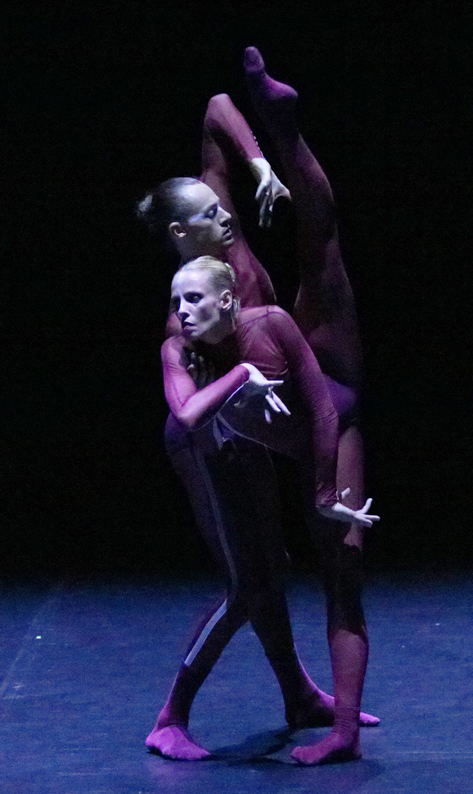
HIGH BREED
Dans High Breed, Jacopo Godani présente une création élémentaire dont la chorégraphie – abstraite et esthétique pure – sert de principal moyen d’expression artistique. Avec une intensité physique riche en action et en exactitude, virtuellement mathématique dans sa précision, Godani introduit la quintessence de l’identité de l’entreprise.

The Geometry of Musical Rhythm: What Makes a “Good” Rhythm Good? ” is a book on the mathematics of rhythms and drum beats. It was written by Godfried Toussaint, in order to study rhythms mathematically, Toussaint abstracts away many of their features that are important musically, involving the sounds or strengths of the individual beats, the phasing of the beats, hierarchically-structured rhythms, or the possibility of music that changes from one rhythm to another. The information that remains describes the beats of each bar (an evenly-spaced cyclic sequence of times) as being either on-beats (times at which a beat is emphasized in the musical performance) or off-beats (times at which it is skipped or performed only weakly). This can be represented combinatorially as a necklace, an equivalence class of binary sequences under rotations, with true binary values representing on-beats and false representing off-beats.
imagen: Ethan-Hein-blog

strange attractors
Dr. Brian Wissman is an Associate Professor of Mathematics at the University of Hawai’i. His work includes creating mathematical visualizations using the Chaoscope program; a 3D rendering software used to create a comprehensible image to explain strange attractors with mathematical sciences. The results are both scientifically informed, and aesthetically beautiful.
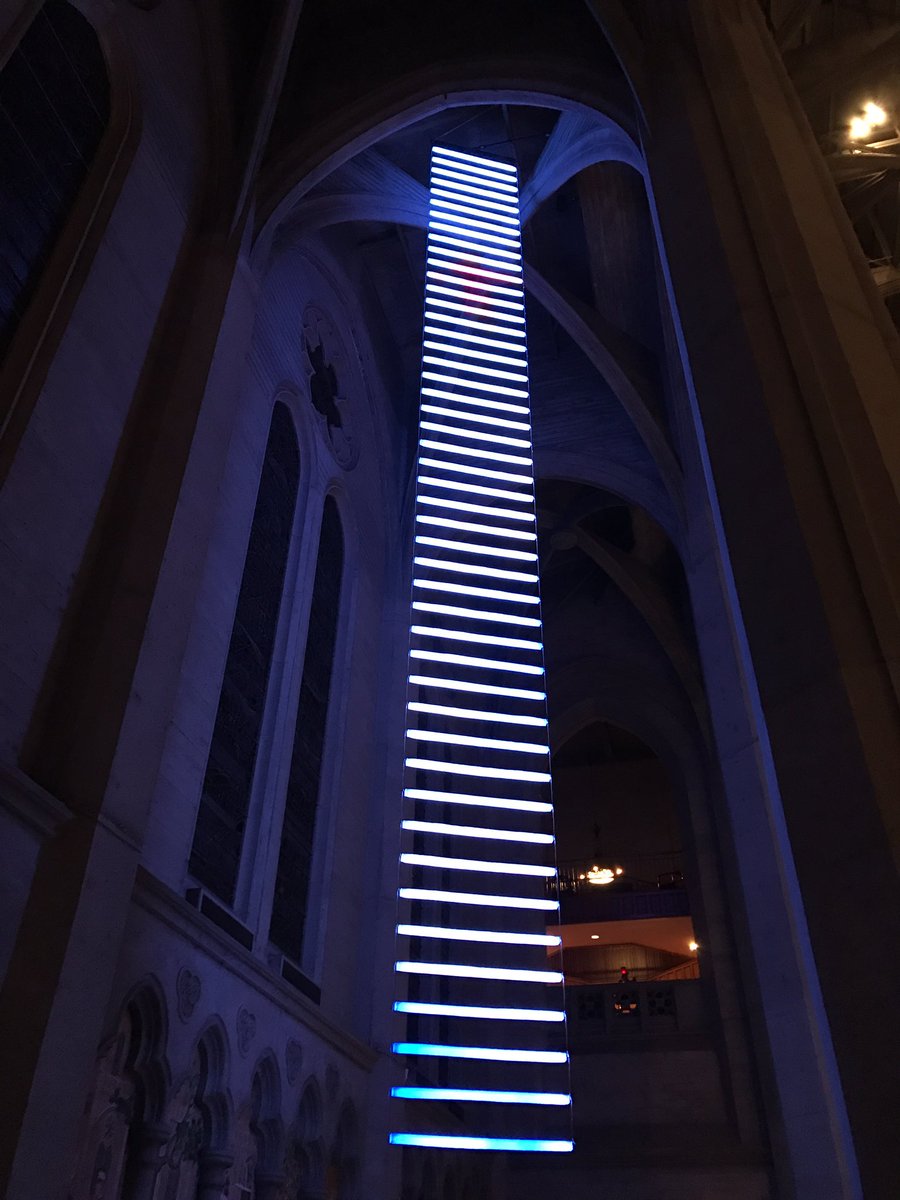
Jacob’dream: a luminous path
San Francisco-based electronic-media artist Jim Campbell creates work that combines film, light emitting diodes (LEDs) and sculptural elements. His choice of materials is often complex, and he uses them to create imagery that is allusive and open-ended. His exploration of the distinction between the analog world and its digital representation metaphorically parallels the difference between poetic understanding versus the mathematics of data.

Data.scape
Permanent Installation
Japan’s leading electronic composer and visual artist Ryoji Ikeda focuses on the essential characteristics of sound itself and that of visuals as light by means of both mathematical precision and mathematical aesthetics. Ikeda has gained a reputation as one of the few international artists working convincingly across both visual and sonic media. He elaborately orchestrates sound, visuals, materials, physical phenomena and mathematical notions into immersive live performances and installations.

池田亮司
이케다 료지
РЕДЗИ ИКЕДА
Data-verse
Ryoji Ikeda’s new trilogy data-verse, commissioned by Audemars Piguet, is an audiovisual symphonic suite that attempts to encompass the tiniest (elementary particles) to the greatest (Universe) scale in Nature.Data-verse is the ultimate chapter of Ikeda’s audiovisual series that first began in 2000, which focuses on his own data-driven research and aesthetics.Through his mathematical composition and aesthetics, massive scientific data set will be processed, transcribed, converted, transformed, de/re/meta-constructed and orchestrated to visualize and sonify the different dimensions that co-exist in our world between the visible and the invisible.

Captives
Captives is an ongoing series of digital and physical sculptures by Quayola and a contemporary homage to Michelangelo’s unfinished series “Prigioni” (1513-1534) and his technique of “non-finito”. The project explores tensions and equilibrium between form and matter, man-made objects of perfection and complex, chaotic forms of nature. In this series mathematical functions and processes describe computer-generated geological formations, endlessly evolving and morphing into classical figures resulting into life-size ‘unfinished’ sculptures.

“Vantongerloo, who ascribes to the abstract language of form after 1917, applies himself to Abstract Art in order to get control of rules by which he develops an interest in geometrical relationships and algebraic formulas. In addition to his artistic practice, Vantongerloo also writes theoretical work about his research. Primarily after the publication of his pamphlet L’Art et son Avenir in 1924, he creates new impulses for geometric abstraction with his writings. In this way, for example, he subjects three neo-plastic works of Piet Mondriaan (1872 – 1944) to an analysis in the French publication Vouloir. In this way he opens up the way for his own ‘mathematical’ abstraction.” Sergio Servellón

Abraham Palatnik
Kinechromatic
His “Kinechromatic Machine” series, first exhibited at the inaugural São Paulo Biennale in 1951, earned him an official award while creating a stir among the judges uncertain on how to classify the novel art form.From 1964 onwards, he developed the Kinetic Objects, an unfolding of the kinechromatics, showing the internal mechanism of operation and suppressing the projection of light. Mathematical rigor is a constant in his work, acting as an important resource for ordering space. He is internationally considered one of the pioneers of kinetic art.

布列茲石
Пьер Булез
Structures I & II
HOMAGE
Ohne ihn wäre die Geschichte der Musik seit 1945 eine andere: Pierre Boulez – Ikone der Neuen Musik, dessen Vehemenz eine der tiefsten ideologischen Spaltungen in der Musik bewirkte. Mit brillanter Polemik forderte er etwa die Sprengung aller Opernhäuser. Seine Kunst des Komponierens machte ihn so einzigartig wie seine Art zu dirigieren.In den 1950er Jahren etablierte sich Boulez definitiv als einer der Komponisten seiner Zeit. Beeinflusst von der Wiener Schule entwickelten die Franzosen Techniken und Kompositionsmethoden, die zum großen Teil auf mathematischen Prinzipien beruhten. 1951 komponierte er Polyphonie X für 18 Instrumente und Structures I für zwei Klaviere, serialistische Stücke schlechthin. Boulez war einer der Schöpfer des integralen Serialismus, ein Konzept, das sich aus Schönbergs Dodekaphonismus ableitet.

Nature Abstraction
Nature Abstraction is an immersive sensory experience that explores the arcane forms of fractals, mathematical visual representation of natural and biological forms.
The project gives an insight of their aspects through virtual reality, where they appear as three planets: Birth, Communion and Aether; Each accompained with scores designed to facilitate meditative state and relaxation;The audience is guided to explore these planets and dive into their vast complexities as well as observing the contrast between the entirely digital created world inside the VR against the fully analogue created film projected onto the faces of the cube which have been filmed in real life, recreating using analogue visual effects and various chemical elements.

ЯНИС КСЕНАКИС
ヤニス·クセナキス
Stratégie
per due Orchestre e due Direttori
Iannis Xenakis est né en 1922 (ou 1921), à Braïla (Roumanie), au sein d’une famille grecque. Il passe sa jeunesse à Athènes, où il achève des études d’ingénieur civil et s’engage d’abord contre l’occupation allemande, puis contre l’occupation britannique (guerre civile). En 1947, après une terrible blessure et une période de clandestinité, il fuit la Grèce et s’installe en France, où il travaille pendant douze ans avec Le Corbusier, en tant qu’ingénieur, puis en tant qu’architecte (Couvent de la Tourette, Pavillon Philips de l’Expo universelle de Bruxelles de 1958 – où fut donné le Poème électronique de Varèse – célèbre pour ses paraboloïdes hyperboliques). En musique, il suit l’enseignement d’Olivier Messiaen et, dans un premier temps, emprunte une voie bartókienne qui tente de combiner le ressourcement dans la musique populaire avec les conquêtes de l’avant-garde (les Anastenaria, 1953). Puis, il décide de rompre avec cette voie et d’emprunter le chemin de l’« abstraction » qui combine deux éléments : d’une part, des références à la physique et aux mathématiques ; d’autre part, un art de la plastique sonore.

The Nutcracker
Waltz of the Flowers
New York City Ballet
“You don’t think of choreographers as mathematicians — yet group dances involve arithmetic and geometry. Nobody mastered those aspects of the art more brilliantly than George Balanchine.
See what he does with the “Waltz of the Flowers” in “The Nutcracker,” as in this short detail:As it begins, 14 women, arrayed in four rows, face front. The two demi-soloists start: They dance from our right to left, with two turning jumps at the end of the phrase. Then a row of four women behind them take up the same phrase — but now the first two women repeat the phrase in the opposite direction, from left to right.It’s like seeing screens sliding in opposite directions. Then the next row takes it up; then the next; suspense and excitement build. It’s an accumulating canon — not spread out across the stage but at close quarters”. Alastair Macaulay
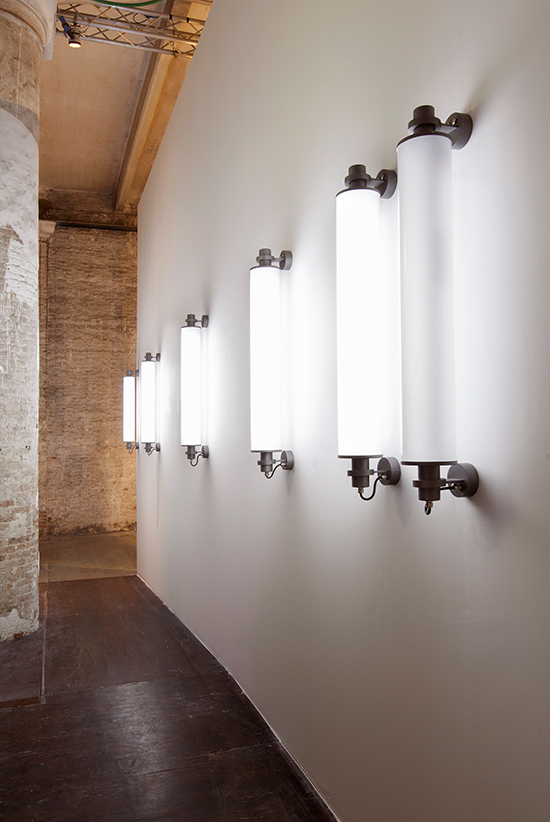
ФИЛИПП ПАРРЕНО
فيليب بارينو
菲利普·帕雷诺
56 FLICKERING LIGHTS
Philippe Parreno, geboren 1964 in Oran, Algerien, lebt und arbeitet in Paris. Nach Abschluss seines Studiums der Mathematik hat Parreno an der Kunstakademie Grenoble studiert, er hat seit etwa 1990 seine Konzepte, Projekte und Filme im Kunstkontext ausgestellt. Parreno’s Werk beschäftigt sich mit der Frage nach dem Status des Bildes und den Formen der Ausstellung. Es verbindet Aspekte aus Kunst, Film, Theater, Design und entwirft transitorische Orte für temporäre, kulturell-ästhetisch definierte Gemeinschaften. Seine komplexen Szenarien aus Bild, Objekt, Sound, Projektion und Licht haben die Wahrnehmung und Erfahrbarkeit des Formats ‚Ausstellung’ neu definiert.

THE DOG DAYS ARE OVER
THE DOG DAYS ARE OVER will be a work that tries to reveal the person behind the dancer. To reach this, a very complex, mathematical, dynamic and tiring choreography is constructed, which is performed almost completely in unison. The difficulty degree of the choreography is so high, that the dancers eventually will go wrong. It is there where the mask falls. The dancer is defined as an idle and purely executing species, striving for perfection.

88.5° Arc x 8
Bernar Venet is a French Conceptual artist known for his curved, mathematically precise metal sculptures, and for his material exploration of coal, asphalt, and tar. “My work is self-generated. Nothing around me serves as a particular inspiration,” Venet said of his art. “I work, and I make discoveries while remaining open-minded to anything that might present a new possibility in the context of my work; this framework looks to enlarge its scope as a result of new formal and conceptual discoveries.” Born on April 20, 1941 in Château-Arnoux-Saint-Auban, the painter and sculptor studied at La Villa Thiole in Nice in 1958 for a year before pursuing a career as an artist. Friends with Arman, Jean Tinguely, Donald Judd, and Sol LeWitt, Venet worked within Minimalist and Conceptualist modes during the 1960s and 1970s.
video

Pocket Landscape
L’installation est composée de quatre segments de ligne principale qui remplissent la galerie: deux rails de train posés directement sur le sol et deux poteaux électriques connectés au réseau électrique local qui, à leur tour, apportent de l’énergie aux ampoules au sodium – la foudre réelle du exposition. Ces lignes fortes traversent la galerie, dépassent les murs et les plafonds, et évoquent le plan cartésien: les rails et les poteaux jouent le rôle des axes x et y d’un graphe, transfigurant l’espace d’exposition en un cube géométrique, l’aire de l’abstraction mathématique. et la rationalisation.

雷蒙格诺
レイモン·クノー
רמונד קנה
Раймонд Кено
OULIPO
Cent mille Milliards de poèmes
Since its arrival (the Oulipo), the rules of the group were set out as follows: “We define potential literature as the search for new forms and structures that can be used by writers in the way they will most like.” “Potential” refers to something that exists in power in literature, that is, that is found within language and that has not necessarily been explored. The favorite tool for study and production is the contrainte, an arbitrary formal restriction that can create new procedures, new forms and literary structures that can generate poems, novels, texts. Over the years, dozens of different contraintes have been explored, from those somehow related to the riddle, such as the palindrome, the acrostic, the lipogram, of which the playful aspect has certainly not been underestimated, with forms more directly related to the codes of exact sciences, such as combinatorial calculus, set theory or graph theory. Among the numerous definitions of the Oulipo provided by the members themselves, one is very elegant and significant: “An Oulipiano is a mouse that builds the labyrinth from which it is proposed to come out later”. Queneau often explained that some of his works might seem simple pastimes, simple jeux d’esprit (mind games), but he remembered that topology or number theory also arose, at least in part, from what was once called “funny mathematics“.

Vielecke und Vielfläche
Regular convex polyhedra, frequently referenced as “Platonic” solids, are featured prominently in the philosophy of Plato, who spoke about them, rather intuitively, in association to the four classical elements (earth, wind, fire, water… plus ether). However, it was Euclid who actually provided a mathematical description of each solid and found the ratio of the diameter of the circumscribed sphere to the length of the edge and argued that there are no further convex polyhedra than those 5: tetrahedron, hexahedron (also known as the cube), octahedron, dodecahedron and icosahedron.
.

Field and Loops
Loops and Fields, is a collection of drawings that resonate sympathetically to the electromagnetic fields within the gallery. These graphite drawings function as graphic antennas and explore the qualities and inherent nature of a combination of hand-drawn and mathematically generated forms. Delving into algorithmic structures, fractals and the chaotic nature of the hand drawn line, these drawings are an exploration of conductive materials and the possibilities for drawing electronic components. When connected to a sound system they make audible their interior activity and reveal the energy that exists in the immediate environment.Relying on the basic principles of the directional loop antenna, the drawings in Loops and Fields, like any receiving antenna, convert an electromagnetic wave into a voltage; the loop antenna is particularly sensitive to magnetic fields and outputs a voltage proportional to that field. Monitoring this activity allows us to experience the local fields and generates a site-specific and dynamic aural landscape.The different shapes and line qualities that make up the algorithmically generated and stencilled drawings come from thinking about the possibilities of extending a line. Fractal mathematics and the research into fractal antennas has focused on reducing the overall size and space an antenna needs to occupy. My interest is in the frequency range at the lower regions of the spectrum, where the wavelength is large; so my interpretation of recent antenna design research has led me to explore the possibilities for drawing antennas that can receive large wavelengths, on something the size of a standard piece of fine art paper.
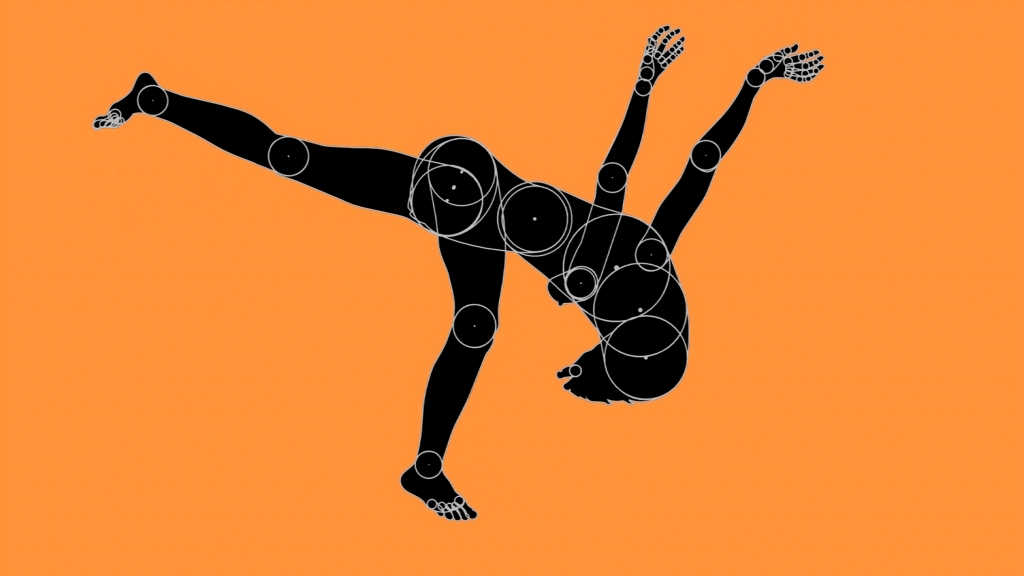
Marionettes
FILE FESTIVAL
“Marionettes” is a seven-minute computer animation about collapse. Marionettes are controlled by strings: if there is no string, they collapse. Nobody animates the body. If nobody animates the body, it will be animated by natural forces. Mass. Gravity. Collision. Randomization. In this animation, the animator does not animate in traditional terms. Thus, we might say it is an anti-animation.
The forces that control the movements of the marionettes are calculated by physical simulation algorithms. Therefore, these movements are strictly mathematical ones. They are dramatic, too. They visualize collapse in its physical and – amazingly enough from puppets animated by machines – psychological sense.
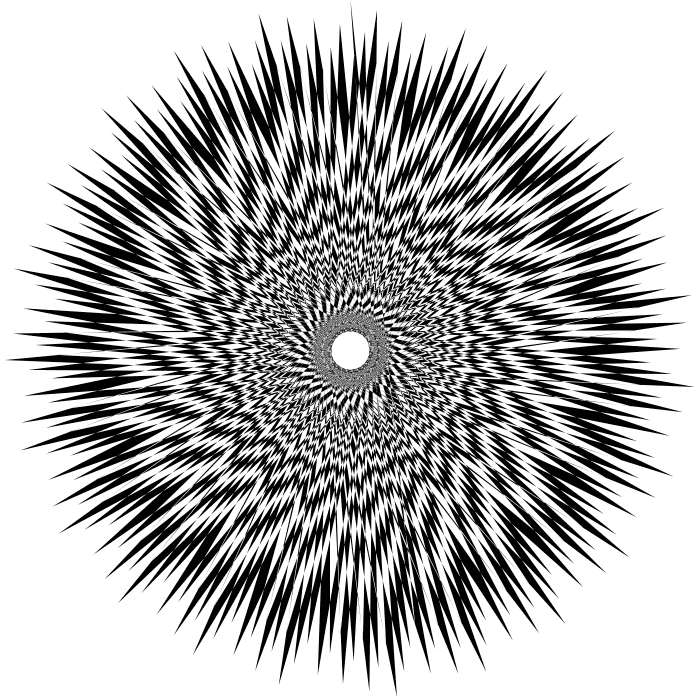
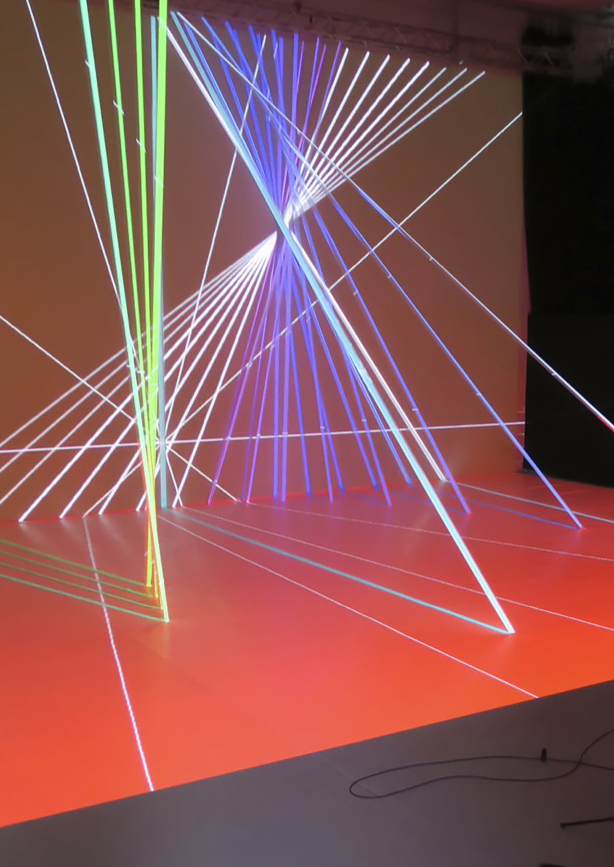
Pow2045
Helle Strahlen durchschneiden den Raum und ersetzen die völlige Dunkelheit. Sie leuchten in bedrohlichem Weiß, wenn sie mit mathematischer Präzision bis zur Decke reichen. Zwei Männer betreten den Raum, während Scanmatrizen ihren Körper wahrnehmen. Sie werden in ihre Bestandteile zerlegt, neu angeordnet und vom Licht manipuliert, bis sie beschließen, die Diktatur der Maschine zu brechen und nichts mehr zu finden – außer sich selbst. Pow ist ein Stück der städtischen Choreografen Raphael Hillebrand und Christian Mio Loclair. Es kombiniert interdisziplinäres Fachwissen, das von computergenerierter Kunst und wissenschaftlicher Mensch-Computer-Interaktion bis hin zu urbaner Choreografie reicht.


Том Беддард
Pyramid
After his PhD, the world of the “dot-com” internet boom was more appealing than academia, so Tom became a web developer specializing in e-commerce content management systems. For the past ten years Tom has worked at a variety of agencies in Scotland and now currently works at Glasgow based 55 Degrees, which specializes in interactive museum exhibits and video production. Tom considers himself to be a ‘creative coder,’ a techie who also has an appreciation for the aesthetics. His site, subblue.com, is where he writes programs and plugins exploring mathematical and generative graphics. Where possible, these experiments are interactive and have the source-code available for download. The exposure of his site and the Photoshop and After Effects plugins he has released have resulted in the creation of book covers, music videos, and stage visuals.

Sculptural Simulacrum
“..Inspiration for this project comes from digital sculpture that created by sculptors who use specialized software to create their work.
In my literature review, I was fascinated to learn how much engineering and math are often involved in digital sculpture and to learn that the process of digital sculpturing has many similarities to pattern making which also relies heavily on mathematic, angles, and precise measurements…” “…One of the most inspiring digital sculptors for me was “Basheba Grossman”. I enjoyed many of his pieces, but was especially inspired from his digitally created bronze knots. In addition to the precise geometry of the knot sculptures, something which, even with the naked eye, it’s apparent that the knots are precise symmetrical pieces. What is also fascinating about the knots is that they exist simultaneously as different shapes that still occupy a single space! Collectively the knots form a sphere, or suggest a cycle or globe, yet the components of the knots are often more like bent stretching disc or arms. The knots have no visible foundation, it is impossible to see where the “starting point” and the “ending point” or even the edges of the sculpture exist..”
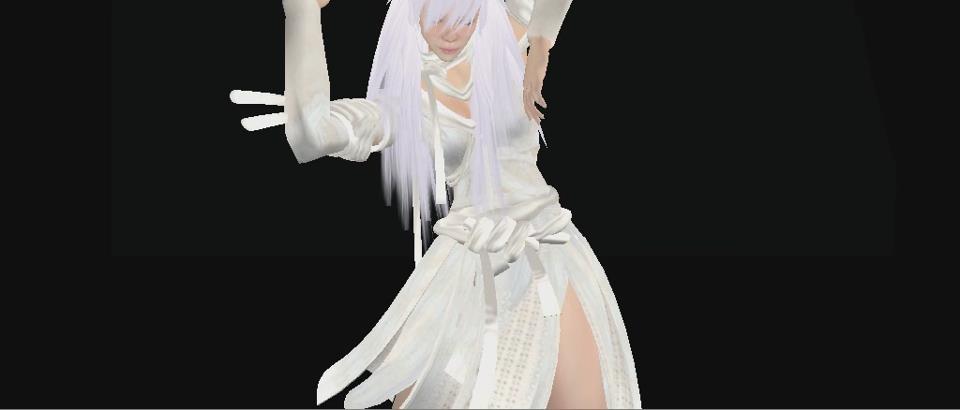
My Life as an Avatar 06.08
File Festival – Machinima
Annie Ok is an interdisciplinary artist. Her work is an expression of entropic congruity and organic abstract deconstruction, inspired by nature, science, mathematics, evolution, dysfunction, ambivalence and ambiguity.